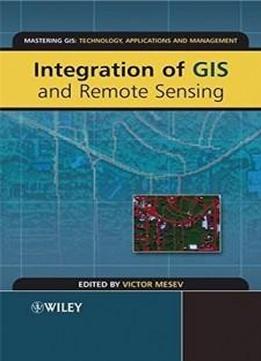
Integration Of Gis And Remote Sensing (mastering Gis: Technol, Applications & Mgmnt)
by Victor Mesev /
2007 / English / PDF
6.1 MB Download
In an age of unprecedented proliferation of data from disparate
sources the urgency is to create efficient methodologies that can
optimise data combinations and at the same time solve increasingly
complex application problems.
In an age of unprecedented proliferation of data from disparate
sources the urgency is to create efficient methodologies that can
optimise data combinations and at the same time solve increasingly
complex application problems.Integration of GIS and Remote
Sensing
Integration of GIS and Remote
Sensing explores the tremendous potential that lies along
the interface between GIS and remote sensing for activating
interoperable databases and instigating information interchange. It
concentrates on the rigorous and meticulous aspects of analytical
data matching and thematic compatibility - the true roots of all
branches of GIS/remote sensing applications. However closer
harmonization is tempered by numerous technical and institutional
issues, including scale incompatibility, measurement disparities,
and the inescapable notion that data from GIS and remote sensing
essentially represent diametrically opposing conceptual views of
reality.
explores the tremendous potential that lies along
the interface between GIS and remote sensing for activating
interoperable databases and instigating information interchange. It
concentrates on the rigorous and meticulous aspects of analytical
data matching and thematic compatibility - the true roots of all
branches of GIS/remote sensing applications. However closer
harmonization is tempered by numerous technical and institutional
issues, including scale incompatibility, measurement disparities,
and the inescapable notion that data from GIS and remote sensing
essentially represent diametrically opposing conceptual views of
reality.
The first part of the book defines and characterises GIS and
remote sensing and presents the reader with an awareness of the
many scale, taxonomical and analytical problems when attempting
integration. The second part of the book moves on to demonstrate
the benefits and costs of integration across a number of human
and environmental applications.
The first part of the book defines and characterises GIS and
remote sensing and presents the reader with an awareness of the
many scale, taxonomical and analytical problems when attempting
integration. The second part of the book moves on to demonstrate
the benefits and costs of integration across a number of human
and environmental applications.
This book is an invaluable reference for students and
professionals dealing not only with GIS and remote sensing, but
also computer science, civil engineering, environmental science
and urban planning within the academic, governmental and
commercial/business sectors.
This book is an invaluable reference for students and
professionals dealing not only with GIS and remote sensing, but
also computer science, civil engineering, environmental science
and urban planning within the academic, governmental and
commercial/business sectors.











